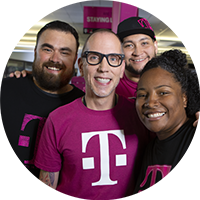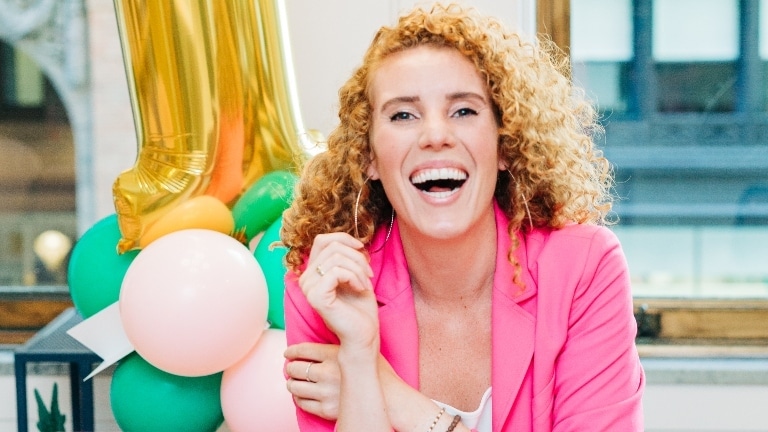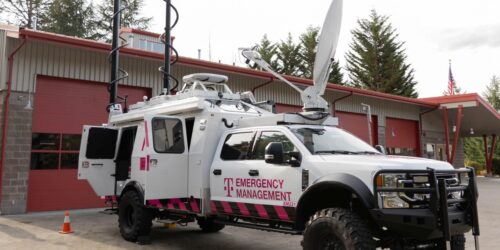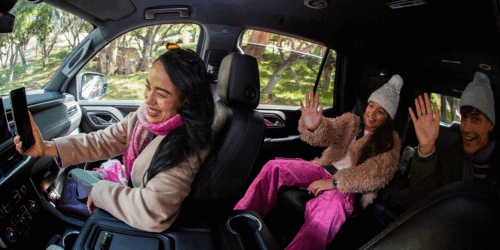Being ahead of the career curve isn’t a recent adjustment for Maxie McCoy, it’s been her mission all along. As a women’s leadership advocate and workplace expert, she was considering the balance of the “real” and “digital” lives many of us have been quickly thrust into well before the COVID era even began — which has made her uniquely suited to speak about how this abrupt shift has and will continue to impact our newly mobile workforce, good and bad.
“If we’re quick to work longer hours while we’re remote, and we’re staring at our devices constantly, we’ll need leaders to begin standing up and supporting people on how to have better habits and hygiene when it comes to technology, remote working, connection, attention, and more,” she says. “Connectivity and technology isn’t the enemy. But how much we rely on it, especially going forward as we experience more remote working, will require that we develop a better, more healthy relationship to it and to ourselves.”
To that end, we take a deep dive with McCoy into everything from the rapidly changing definition of workplace to the extra burdens working women tend to carry to how mobile technology and our new comfort levels will reset how we all work now and in the future.
Can you walk me through your experience a bit, and where your expertise lies?
Gathering women and facilitating their stories is my life’s work. “Community” is such a hot word right now. To me it’s the “newest old thing” because I’ve been building communities almost my entire career. The key to building a community is unlocking the power amongst one another. The way I’ve always done that is to use stories as our connective tissue, and to be the facilitator of those stories. There’s something really special that happens when you’re able to take what happens offline, and let it continue online, then let that pulse back to IRL [in real life] connection. Eventually it’s a virtuous cycle where digital and live spaces support one another, making the whole bigger than its parts.
My career has embedded those ideas into the women’s leadership space with a real belief that consistent, ritualized interactions amongst women can elevate not only our individual lives but our collective experience. If we have the stories that are born from those interactions, we have answers for a path forward. Soon, that path will lead to more gender equity in the workplace and beyond.
My “rocket ship” in this space began in building a 30-city local network for a millennial career platform. I wrote my book You’re Not Lost: An Inspired Action Plan for Finding Your Own Way as a solution for the women in those communities who had told me for years they were feeling lost. I’ve helped build experiential digital and offline communities for companies big and small. Right now, most of my focus is on supporting The Riveter, a modern union of working women, as they activate support and community for the 75 million working women in America, and WOMAN ON, a live (digital) audience talk show and community focused on helping women make the right, next decisions.
How has your thinking on the topic of “workplace” or even “working” changed in the last few months?
It’s been turned upside down! Well, that was my first thought. However, when I take a step back and really look at what we’re seeing here, it’s more “the top has blown off” of everything that was rising to the surface. Working and workplaces have long been synonymous with offices even though the technology that would have made separating the two was already in place. “Working from anywhere” (at scale) was viewed impossible. The last few months have shown us it’s indeed, possible. I’ve been excited for others to see this possibility because I’ve been a remote worker for 8 years in all the various hats of my employment (full-time employee, consultant, business owner). Remote work worked for me, because it does work.
That acceptance around normalizing the deskless worker is a big win. Many people, especially in spaces that advocate for change for underrepresented groups, have known that old ways of work weren’t working for many groups of people. In my work within the women’s leadership space, there’s so much literature on how flexible, remote work is important in breaking the glass ceiling — and the maternal wall. It allows women to better manage caretaking (75% of caretakers are women) while they pursue their careers. That’s hard, however, when you’re a flexible or remote worker but your whole organization or team is in the 9-5, butts in seats, grind. I wish I could say the past few months has evened the playing field with everyone (who can be) remote, but right now it’s not because women are feeling the brunt of both unemployment and caretaking. Especially those with children at home … they’re having to teach and program kids’ days with less help from schools, daycares or summer camps. Hopefully, that’s temporary, and that long-term these shifts to flexible, remote working are positive ones.
We’re seeing a lot of changes in real time to how people and companies are working. What are some of the shifts that stand out to you, and why do they matter?
The headlines on this topic are making many of us wonder if the decisions we made to orient our lives a certain way still apply. For example, do I need to live in a big city to have upward mobility and good employment opportunities? Do I need to work near an office or headquarters in order to be equal with my peers? Do I need to invest in the overhead of rent and utilities in order to start a business? We’re seeing a reevaluation of what we thought or knew to be true.
It requires a quick adaptation of the innovations that makes a mobile workforce operational, like collaboration tools, 5G and video technologies. For example, a few weeks ago I needed to run a timely errand for my elderly neighbor who can’t leave his home, but I had an important meeting that I needed to be on video for. I was able to do both because my phone and network connection enabled that for me. I was able to toggle between Zoom, Slack and email from my phone while walking the streets of San Francisco to help Ralph. Even as someone who’s lived in the Bay Area and was an early adopter of these tools, I don’t know if I would have been as confident to attempt both if it hadn’t been for this time normalizing those behaviors not only for me but for the people I’m collaborating with.
These shifts are bringing those that weren’t first to embrace mobile working onboard to a new way of collaborating. Those of us that have been here are normalizing working on the go without it being deemed as “unfocused” or judged overall. We are living the future of work, right now.
What are some of the surprising takeaways you’ve seen develop quickly over the last few months?
Aside from the very quick embrace of “an office-free daily life,” I’ve long felt that when you’re working remotely, you work more. Emphasis on the word felt because I had no data to prove that hypothesis. Rather, it was my own experiences of years of remote working under my belt and feeling like I was both (potentially) more productive and prone to working longer hours (if better boundaries weren’t set and adhered). It took me a long time to realize that just because I was up and at ‘em, didn’t mean I needed to be up and working. To see that the American work day has increased by about 40% — adding roughly three hours during a pandemic! — was both surprising and honestly, concerning.
On a positive note, however, I’ve loved seeing how many people have turned to virtual learning, programming and communities. I’ve long known (and built) digital experiences that can support offline ones. Watching business owners translate their work online, and being able to contribute my expertise to that, has been really wonderful. Because building digital communities and product offerings right now won’t be for naught. It’ll be something that any business owner or brand can continue benefiting from long after there’s a vaccine. And consumers are more apt, now, to consume those digital offerings while on the go thanks to advanced network capabilities, better devices and stronger platforms. Admittedly, it’s all coming together at a hard and difficult time.
What are your hopes for the new normal when it comes to the workplace — is there a positive story to dig into here, as well as the uncertainty?
I’m hopeful that we’ll become better at working together. We’ve long known that a more diverse workforce is a more successful one. I’d like to see this “new normal” be a shift in giving more opportunities to underrepresented talent — like those who can’t afford to live in the tier-one cities, or those who need to stay close to aging parents, or those who aren’t able to go into an office every day because of disabilities. I know there’s an impossible amount of work to be done before we’re in an equitable world, but I hope that more leaders seeing the fruits and possibilities of mobile work will allow for more opportunities for those who haven’t historically had them in our old ways of operating.
What will we need to consider moving forward, given what we’ve learned the last couple months, when it comes to both physical and virtual boundaries?
So much has changed. We talk about the “new normal” but really we’re headed into the “new new.” While I can’t predict the future (obviously), we’re not returning to where we once were, especially when it comes to work. The self-care and wellness space has been booming for a few years now. We’re talking about a $4.5 trillion dollar wellness economy. I think these shifts in remote work will actually further the need for individuals, companies and employers to focus on mental and emotional health.
Even as long as I’ve been accustomed to mobile working — working while traveling to speak at conferences, working while living in Indonesia for a year, working while home visiting family — these past few months have been difficult for all the obvious reasons, but also because I realized that just because I’ve learned to create boundaries with virtual workspaces doesn’t mean these “newly mobile workers” that I’m collaborating with have. Once I realized that, I had more compassion for myself and the newly lost boundaries I’d spent years learning to define.
What do we need to keep our eye on in order for women to see the opportunities of these shifts that you mentioned above?
Natural facilitators are going to be even more important if we want inclusive remote meetings for women, people of color, LGBTQIA+. As someone who facilitates for a living, it’s a skillset that is really important, especially if we want all voices at the table. We know from in-real-life meeting spaces that individuals from these communities especially are the first to be ignored or explained over. Leaders and meeting owners will need to become adept at equitable facilitation, and work to make sure underrepresented voices have the spotlight. Organization leaders shifting into remote work would benefit from following the work of inclusion experts like Minda Harts, author of The Memo, to understand how to ensure that diversity, equity and inclusion become embedded in these “new” remote cultures.
Can you tell us a little bit about your partnership with T-Mobile, and what we’ll be seeing in the weeks to come and where to find it?
I’m thrilled to be working with T-Mobile on experiences that can support mobile workers and simultaneously elevate their wellbeing. I feel strongly that together we can support people through uncertain times to have a better grasp on how to use connectivity to level up their lives, which sometimes includes powering down. You’ll see a lot of what we do together here on T-Mobile’s channels and mine on @maxiemccoy and maxiemccoy.com. This is just the beginning!





